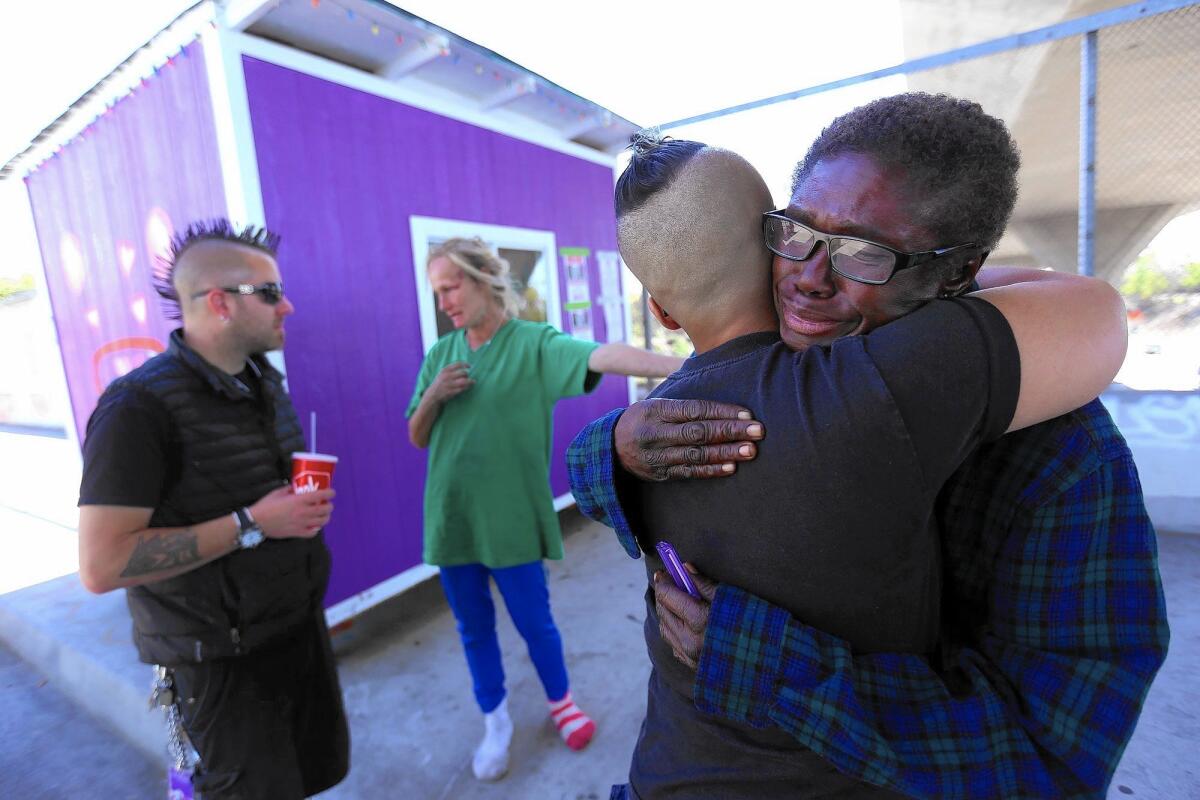‘Tiny houses’ for the homeless seen as health and safety problem

For months, gaily painted wooden houses on South Los Angeles freeway overpasses had intrigued motorists looking up from the roads below.
The 6-by-10-foot structures, it turned out, were homes for the homeless that Elvis Summers had built and placed in several encampments around the city.
Each house, about the size of a garden shed, came with an American flag, solar-powered lights and a house number, proudly displayed next to the front door.
“It’s psychology,” said Summers, a self-described struggling musician who lives in South L.A. “The slightest thing you do to make them feel normal is so important. They’re treated like garbage.”
On Thursday, Summers raced to remove eight small houses ahead of city sanitation workers sent to impound and possibly destroy them. Summers’ crusade had run into Los Angeles’ intractable homelessness crisis.
After grappling for years to curb the nation’s biggest street population, city officials in recent years saw homeless numbers grow, and shantytowns spread from Northeast L.A.’s arroyo to the beaches of Pacific Palisades.
Seeking to maintain order while not trampling the rights of the destitute, officials adopted a tough ordinance to sweep out camps, as well as a $2-billion homelessness plan with new shelter and housing options.
The city, however, is struggling with how to pay for the plan. In the meantime, homeless advocates discovered tiny houses.
Popularized as part of a lifestyle-downsizing movement, the bare-bones structures appealed to supporters as a simple and safe alternative to people sleeping on the sidewalk. The sweeps ordinance, however, targeted tiny houses to be seized and discarded as “bulky items.”
See more of our top stories on Facebook >>
Three of Summers’ houses confiscated from a South L.A. overpass during a cleanup earlier this month are stashed in a city equipment lot while the City Council deliberates their fate, officials said. Summers hauled eight others to a Compton church lot and other locations, sending occupants back to the sidewalks.
Councilman Curren Price, who requested the cleanup, said the structures posed a serious health and safety problem.
“Police have identified firearms, drug activity going on,” Price said. “A box of plywood is still a box.”
Price said the homeless people had been offered alternatives, including shelter beds.
“When the city took the houses, they didn’t offer housing, they straight kicked them out,” Summers countered.
Summers, 38, who said he was briefly homeless in Orange County, recalls discovering tiny houses — where else? — on the Internet.
He decided to build one for a homeless woman in his neighborhood, he said. After millions viewed an online video showing how he constructed it, about $100,000 poured into his crowd-sourced fundraising site.
“My favorite was 5-year-old Finley from Australia who gave $5,” Summers said.
Summers wears a Mohawk and casual hipster clothes, but his followers come from many walks of life.
“I want to stand behind this,” said Eiffel Bullard, 46, a South L.A. child-care provider who drove to the overpass to lend support.
Before the homes overlooking the 110 Freeway were hauled off, residents had begun to personalize them.
The outside of June Briggs Cannon’s house featured a mural of a pink convertible trailing shoes captioned “Just Married.” Summers said he arranged Cannon’s marriage to her longtime partner, Larry Joe.
Kenner Jackson, who lived in a tiny house with his wife, Becky, and terrier, Cowboy, expanded his homestead, planting collard greens, tomatoes and succulents in a dirt patch and setting up chairs, a table and a bench under a shade tarp.
Inside the structure, Jackson showed off a microwave, stereo system and TV — all powered by the rooftop solar panel — and a propane cooking stove. Most important, Jackson said, the front door locked.
“Security is our No. 1 priority,” Jackson said.
Neighbors, however, said Summers’ homes threatened their security, bringing crime, drugs, theft and prostitution into a community already struggling with gangs and violence.
“Elvis provided these people what I call an outhouse,” said June Ellen Richard, who described herself as a lifelong resident of the neighborhood. “A house that looks like Snoopy.”
Resident Charlie Espinosa complained that Summers had placed the houses in the neighborhood without consulting anyone. “We are insulted and we are hurt, we really are,” Espinosa said.
Summers said it was unfair to blame the houses for a drug problem among the homeless that already existed.
He said he put the houses by the freeway because they would not block businesses or other residences. His ultimate goal, he added, was to get land — perhaps an empty lot next to the Compton church — for a tiny-house village.
Cities such as Seattle and Nashville are experimenting with such camps. Portland, Ore., has approved two self-governing homeless encampments that include small huts or tiny houses, said Kurt Creager, director of the Portland Housing Bureau.
“The expense to the city is minimal,” just water, power and sanitation, Creager said.
Los Angeles has tried camps before. The city opened a downtown shantytown in the 1980s. Homeless activist Ted Hayes later launched a self-governing enclave called Justiceville.
It was reborn as Dome Village in 1993 in a parking lot near what is now Staples Center. Homeless people lived in geodesic domes — the tiny houses of their day. Rising land values drove the village out in 2005.
Critics say camps simply prolong homelessness.
“You can’t reintegrate into society in a doghouse,” said longtime homeless activist and writer Robert Chambers.
Summers said he has tried contacting officials about the village idea but none has responded.
Mayor Eric Garcetti’s spokeswoman said he is focused on getting people into permanent housing.
“Unfortunately, these structures can be hazardous to the individuals living in them and to the community at large,” spokeswoman Connie Llanos said in a statement.
Even as Summers hustled this week to remove the eight houses from South L.A. before the city could take them, he said he still has 26 in places “where [officials] can’t find them,” in communities such as Van Nuys and Inglewood.
“They keep just saying we need permanent housing, but it never happens,” Summers said. “It’s not a permanent solution, but nobody else gives a crap about these people.”
Twitter: @geholland
ALSO
California Highway Patrol needed nearly four hours to catch a runaway ‘unicorn’
Ku Klux Klan plans rally in Anaheim, sparking concern from residents
Lawsuits against Trump University claim students paid thousands for nothing
More to Read
Start your day right
Sign up for Essential California for news, features and recommendations from the L.A. Times and beyond in your inbox six days a week.
You may occasionally receive promotional content from the Los Angeles Times.







